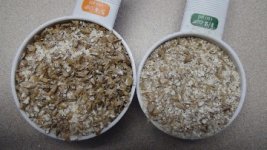I'm sure this has probably been discussed but does anyone have any tips on getting better efficiencies?
On normal gravity batches I'm usually around 65% and higher gravity batches I can't break 50%. I batch sparge for its simplicity but I never feel like I'm sparging enough. When I'm only brewing 5 gallon batches I can't have 10 gallons of runoff.
If I changed to more complex methods would it help?
I am careful with my temps times and water volume according to beersmith but beersmith is silent on the amount of sparge water to use.
Help! Its frustrating to expect a 1.073 weizenbock and end up with a 1.055 dunkleweiss.
On normal gravity batches I'm usually around 65% and higher gravity batches I can't break 50%. I batch sparge for its simplicity but I never feel like I'm sparging enough. When I'm only brewing 5 gallon batches I can't have 10 gallons of runoff.
If I changed to more complex methods would it help?
I am careful with my temps times and water volume according to beersmith but beersmith is silent on the amount of sparge water to use.
Help! Its frustrating to expect a 1.073 weizenbock and end up with a 1.055 dunkleweiss.

